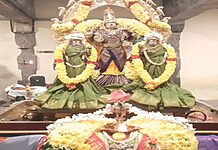Prime Minister Narendra Modi Last May, he ceremonially installed the scepter, a symbol of ancient South Indian dharma kingship, next to the Speaker’s chair in India’s new Parliament building.
Samajwadi Party Lok Sabha MP RK Chowdhury on Wednesday (June 26) said, “Scepter is king’s rod… Now that the country has achieved independence, will it be ruled by the king’s rod or by the constitution? “I demand the removal of the scepter from Parliament to save the Constitution,” he demanded.
Here is an Indian Express interview with historian Manu S Pillai in 2023 about the history, cultural and political significance of the scepter and its installation in the new Parliament building.
What is a scepter? What is the tradition associated with it? To which period and which dynasties does it belong to?
The scepter represents kingship, justice and authority. It has to do with the proper exercise of power. Its origins lie in Tamil Nadu, and it served as a royal symbol. For example, among the Madurai Nayaks, the scepter was placed in front of Goddess Meenakshi in the main temple on important occasions and then moved to the throne room, signifying the king’s role as a divine messenger.
Hence, it was also a legal instrument. For example, when the Sethupatis of Ramanatha first attained royal status in the seventeenth century, they received a ritually consecrated scepter from the priests of the Rameswaram temple.
It was the accountability of the ruler to the deity in the exercise of power, and marked his graduation from the rank of principal to the most exalted king.
Thus, the scepter can be described in its historical context as a symbol of Dharma kingship.
About the ceremony of handing over the scepter to Nehru in 1947?
It originates from some oral information mixed with some facts. It appears that Nehru was given the scepter by Hindu leaders from Tamil Nadu and accepted it. But it seems an exaggeration to say that this was a momentous occasion, and that Lord Mountbatten handed it over ceremoniously to mark a transfer of power.
Any moment of that nature would have been widely recorded and reported. The great lover of the Mountbatten match would not have refrained from making a big deal about the affair.
The obscurity of this scepter and the lack of sufficient contemporary evidence suggest that it was not a major episode in 1947, but rather a marginal incident. Hindu leaders presented it to Nehru as a mark of respect and he received it with good heart.
From what is known of Nehru’s personality, he was not the type to be attracted to royal rituals. So it is not surprising that this scepter is in a museum.
The government claimed that it was C Rajagopalachari who recommended the ceremony to Nehru. Is this true? If yes, why did Rajagopalachari recommend it?
Only the government can answer this. One believes they have done their research and puts the necessary documents and information in the public domain to support their position. After all, the claim being made is great; It must be sustained with equally convincing evidence.
Beyond Tamil Hindu leaders giving Nehru a sceptre, the rest of the story is believed in some quarters to be exaggerated.
This sort of thing is not uncommon in our country, and historians often find that there is some truth in fascinating stories.
We often come across situations where there is enough truth to make the story appear credible, until closer inspection leaves the story disintegrating and residue. But this remnant may not be attractive to the public imagination; People often prefer the best story to the facts
The government also said that the scepter was a symbol of the transfer of power from the British to Indian hands. Is this true? If not, what does the scepter represent?
Again, the government needs to explain this. If this is an important symbol of the transfer of power, it is surprising that so few will have heard of it until the summer of 2023. Yes, the scepter bearers meant it that way. Recognition of formal authority, that is what the scepter represents. But this event seems to be a minor one.
However, the government wants to highlight it today as part of a massive project to construct Hindu political history. In a sense, Nehru’s scepter was a means of adding legitimacy and status to the current government over the first government of independent India.
Think of it as an act based on cultural commitment. The government wants to evoke a new symbol, new meanings.
Nehru and his successors saw it in a museum, displayed by our present rulers as part of a tradition that needed to be resurrected.
So what is the significance of Prime Minister Narendra Modi installing the historic scepter near the Lok Sabha Speaker’s seat during the inauguration of the new Parliament?
The new parliament is a monument to breaking with the past. It is not just a utility building. Erection of idols, construction of Ram temple and projects supported and/or encouraged by the government is a reconstruction of the national narrative.
The Prime Minister is not insisting on constitutional norms but rather a culture or some may say civilisation.
Placing the scepter next to the Speaker’s chair is to give that chair to a more overt Hinduism. This changed the meaning we had accepted until now through Western parliamentary conventions.
The Prime Minister and his supporters will see it as an act of cultural renaissance; Others still lament the political Hinduization of a national symbol.









